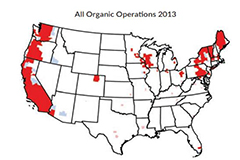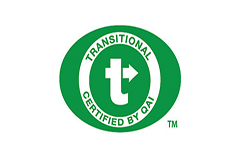


Sign-up for {N}power to get exclusive discounts, newsletters, members-only features, and more!
 Denver - Design District - Alameda and Broadway
Denver - Design District - Alameda and Broadway
368 S Broadway
Denver, CO 80209
United States
 Preferred Store:
Select a Store
Preferred Store:
Select a Store

Supporters of organic agriculture have long championed its benefits for personal health and sustainability, but a new report suggests that organic farming might also make for a stronger local economy.
The Organic Trade Association (OTA) recently released a report on what it calls “organic hotspots” in the United States, and how these hotspots benefit local economies.[1] According to the report, authored by Penn State University associate professor of agricultural economics, Edward C. Jaenicke, there are 225 counties in the U.S. that can be classified as organic hotspots that positively impact two key county-level economic indicators—the county poverty rate and the median household income.
 What is an organic hotspot? An organic hotspot is a cluster of counties with two important characteristics: They are counties with statistically high numbers of organic operations (farms and businesses) and they have neighboring counties with high numbers of organic operations.
What is an organic hotspot? An organic hotspot is a cluster of counties with two important characteristics: They are counties with statistically high numbers of organic operations (farms and businesses) and they have neighboring counties with high numbers of organic operations.
Where are organic hotspots? They are particularly strong on the West Coast, wherein 2013 a single hotspot of contiguous counties stretched from California to Washington. Smaller hotspots also appear in the northern Midwest anchored on Wisconsin, in several parts of New England, and the northern Mid-Atlantic states, plus a few additional isolated areas.
What is the economic impact to a county from being in an organic hotspot? A county’s poverty rate drops by 1.3 percentage points and the median household income increases an average of $2,094 when the county is part of an organic hotspot. This remarkable result is perhaps the first to link local economic health to organic agriculture. Recent studies offer context for comparison: Using 2014 data, the U.S. Census finds the presence of the Supplemental Nutrition Assistant Program
[1] https://ota.com/sites/default/files/indexed_files/OTA-HotSpotsWhitePaper-OnlineVersion.pdf
(SNAP) was responsible for a 1.5 percentage point reduction in the overall poverty rate, while the Special Supplemental Nutrition Program for Women, Infants, and Children (WIC) was responsible for a 0.1 percentage point decrease in the poverty rate.[2]

The report didn’t investigate why this happens, but Jaenicke says that organic operations might hire more local labor, encourage shorter supply chains, and even spur growth as part of the so-called “creative economy” of entrepreneurship.
Why does this matter? This study is the first of its kind to positively link organic agriculture and local economic development, showing that organic agriculture can be used as an economic development tool. Organic agriculture has been proven to benefit our environment and our bodies, and now this report shows that organic agriculture—and the business activities accompanying organic agriculture—can also benefit local economies and help secure the financial future of many.
It also comes at a complex time in the organic landscape. Organic sales continue to grow every year and recent research has shown that organic agriculture earns farmers significantly more than conventional farming. But the demand for organic products in the United States has also outpaced its production,[3] resulting in a large amount of organic food being imported from other countries. So how can we support American farmers and our own local economies?
 Look for products with the Certified Transitional label. These are products that support farms in transition—they are sold at a higher price point to help compensate for the increased costs of transitioning to organic production. This program provides certification to recognize and incentivize farmers to transition their land from conventional to organic growing methods.
Look for products with the Certified Transitional label. These are products that support farms in transition—they are sold at a higher price point to help compensate for the increased costs of transitioning to organic production. This program provides certification to recognize and incentivize farmers to transition their land from conventional to organic growing methods.
While organic products can fetch higher prices, it takes three years for a farm to transition from conventional to organic, and typically farmers are not compensated for the initial costs of converting their land. This label raises awareness for consumers, provides more choices in the marketplace, and allows premium pricing to be distributed down to the farms in transition.[4] Kashi’s Dark Cocoa Karma is an example of a product with Certified Transitional ingredients.
Continue to buy USDA organic. It’s great to see that organic products have moved from a niche market to the mainstream and that organic agriculture is continuing to gain momentum. However, less than one percent of our current agricultural land is under organic management, so we still have a long way to go. Organic agriculture not only supports the economy by being more profitable for the farmers and the communities they live in—organic foods are also good4u and good for the environment. By selling only 100% USDA-certified organic produce, Natural Grocers is your Organic Headquarters. We are your go-to for supporting organic agriculture while shopping for your favorite organic goodies.
Remember that you get to influence agricultural production three times a day, with every meal, and by buying organic produce and other organic products, you are supporting your health, the health of the environment, and the health of the economy!
[2] https://aspe.hhs.gov/system/files/pdf/154286/50YearTrends.pdf
[3] https://www.usatoday.com/story/money/2015/08/05/organic-farmers-face-growing-pains-demand-outpaces-supply/31116235/
[4] http://www.qai-inc.com/certification-services/transitional.php



Sign-up for {N}power to get exclusive discounts, newsletters, members-only features, and more!
